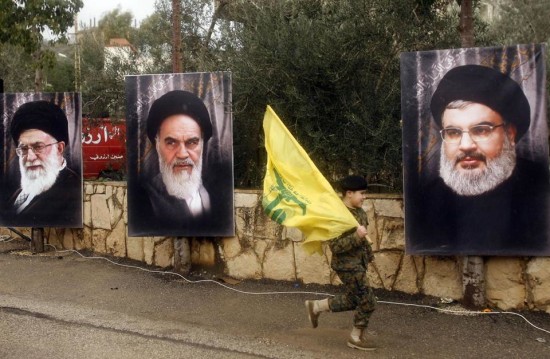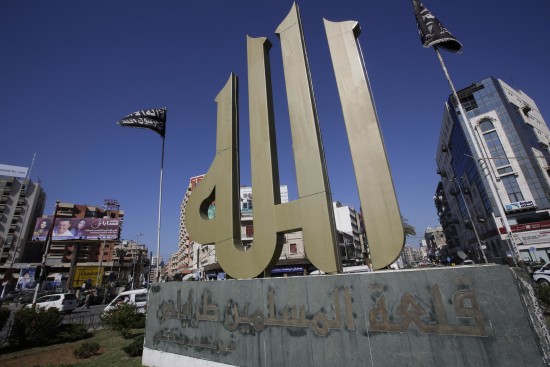Signs and Incitement
Photo: MAHMOUD ZAYYAT/AFP/GETTY IMAGES
[Published in The Boston Globe Ideas.]
LEBANON’S MOST powerful Sunni and Shia warlords entered delicate negotiations to calm sectarian strife earlier this year, terrified that the mass killing in next-door Syria was about to engulf their own country.
There were many prickly agenda items: the central role that the Shia party Hezbollah plays in propping up Syria’s dictatorship; the cozy relationship between rich Sunni bosses and the crop of nihilist jihadis who are responsible for some of the most chilling murders; and a spate of beheadings and riots.
In the end, the two sides could agree on only one major concession to cool the conflict from the boiling point it had reached: Take down the big posters.
This compromise, at first glance, may sound almost pitifully small. At the time, Sunni jihadists were killing national army soldiers in the mountain town of Arsal, while Shia neighborhoods were celebrating their war martyrs as the only defense against the creation of a stifling, genocidal caliphate. And the only thing that sectarian leaders could agree on was a moratorium on images and iconography.
Yet the accord makes a powerful true-life argument about incitement.
The ubiquitous images of martyrs, religious leaders, and warlords, the slogans about death, sacrifice, and religions painted on walls and banners, both sides agreed, posed a genuine risk. Taking down some of the most intense signs of sectarian propaganda isn’t as big a step as disarming a militia, but in Lebanon’s ongoing experiment with religious and communal tension, this spring’s accord over visual propaganda marks an important test.
If the architects of the agreement and the social scientists who argue that the visual displays of sectarianism raise fears and the risk of violence are right, then Lebanon will reap major dividends from the iconography gambit — and in the process, give credence to the argument that visual propaganda plays an integral role in conflict.
But just how important are these signs and slogans? Can posters actually shape people’s identities and political views, mobilize them to fight, prime them to enter a zero-sum struggle against other people whom they consider different and less human? Or do they merely reflect discord and sectarianism that come from conflicts over resources and are nurtured slowly in places like schools, mosques, and churches?
“These flags are everywhere. We need a break from them,” said Jeanine Jalkh, a Lebanese journalist who has written extensively about ways to heal war-torn societies.
Tens of thousands of dead from the Lebanese Civil War, which raged from 1975 to 1991, are still unaccounted for; many victims are believed to have been killed by warlords and factions that still predominate today. So for many Lebanese, Jalkh said, the banners and flags they pass every day serve as a painful reminder of an enemy group that might still control their neighborhood — and that they hold responsible for a major, unprocessed loss. “To make peace, we’re going to need a multifaceted process,” she said. “We’re going to have to deal with memory, and with accountability.” Toning down the symbols, Jalkh believes, is a great place to start.
ACROSS THE ARAB world, the fight for power increasingly is being waged in sectarian terms, by militias whose loyalists and leaders identify themselves as Sunni, Shia, Christian, or some offshoot sect rather than by any other ethnic or political identity.
It’s not always accurate, but the signs and banners make a good bellwether of where the conflict stands. When sectarian militias are enjoying an entente, the peacocking subsides: no new posters and flags, none of the enormous billboards, and building-sized banners. When tensions run high, on the other hand, sectarian iconography proliferates.
The first steps to remove the icons in Lebanon went smoothly. In March, Hezbollah and its biggest Shia ally, the Amal movement, dismantled some of their largest party banners hanging in Beirut. The main Sunni party, the Future Movement, took down many of its posters and banners in Beirut and the cities of Sidon and Tripoli, which have diverse populations but also host concentrations of Sunni jihadists.
Mixed neighborhoods and sectarian borders have, not surprisingly, been the biggest flashpoints in Lebanon. As a result, these areas also host some of the more in-your-face iconography. The main highway to the airport, for instance, is a road that nearly everyone in the country travels. It also passes through Hezbollah’s heartland in South Beirut. The party has erected dozens of massive posters featuring Hezbollah martyrs along the motorway and raised hackles when they erected photographs of visiting Iranian President Mahmoud Ahmedinejad in 2010, an event that many Sunnis still bring up today. Entrances to Christian neighborhoods, meanwhile, are often marked by spray-painted or stenciled crosses on walls — most often a stylized cross of the Lebanese Forces, a militia responsible for many of the worst atrocities of the civil war — and photographs of their militia-leaders-turned-politicians.
It was in Tripoli, Lebanon’s second largest city, that the campaign to calm sectarian tensions hit a bump. Since 2011, rounds of violence have wracked the city, pitting local Sunnis, who support the Syrian uprising, against Alawites, who support the Assad regime. Both communities have been sending fighters and weapons to Syria since fighting broke out there, and Lebanese politicians have tried in vain to keep their fighting on the far side of the border.
The city’s Sunni majority nurses a host of grievances. Poverty and unemployment are endemic. The central government has neglected Tripoli for decades. The city’s Sunni leaders, many of whom are multimillionaires and at least one of whom is a billionaire former prime minister, have stoked a sense of sectarian grievance while doing nothing themselves to help the city. Militancy and jihadist thought has proliferated among the Sunni populace, along with a sense that they are subject to punishment only because they are Sunni while the Lebanese Army and government are dominated by Shia and Christian movements.
One night this spring, Khaled el-Daher, a populist Sunni Islamist member of parliament, heard that the regional governor was removing jihadist flags from Nour Square, the symbolic gateway to Tripoli. He instantly framed it as a religious war against Sunnis and summoned a who’s-who of hard-core religious activists and jihadi sympathizers to join him in the square after midnight.
“This is a humiliation for the Sunnis!” he shouted to the crowd and assembled media. “If there is a decision to remove religious flags, let it be imposed on all religions, Muslim and Christian. Let them start with the crosses on the churches in Beirut and the statue of Christ the King in Jounieh!”
Daher’s stand brought Tripoli to the verge of open warfare, as Lebanese Christians, many of whom already feel politically marginalized and vulnerable, were stirred into action. The central importance of the sectarian symbols that adorn conflict in the region became immediately clear — as was the difficulty of taking even the most extreme of those down.
The centerpiece of Nour Square is a statue, about 10 feet high, of the word “God” written in simple Arabic calligraphy. A smaller sign identifies Tripoli as “the citadel of the Muslims.” Around the statue hang flags with verses of the Koran in Arabic script. Daher, an influential boss who was a member of the Sunni Future Movement until he was expelled as a result of his grandstanding about the flags, is unapologetic.
“This is God!” he explained in an interview. “Will you remove God from our city?”
JOSEPH EID/AFP/GETTY IMAGES
The centerpiece of Nour Square in Tripoli is a statue of the word “God” written in Arabic calligraphy.
Islamic leaders and movements have flown flags with professions of faith ever since the time of the Prophet Mohammed. Today extremist groups, including ISIS and Al Qaeda, have adopted one form of this traditional flag as their battle standard, creating a vexing issue for purists like Daher.
Some Sunni leaders have found an easy workaround: Hang the same slogans on white flags, to keep the focus clearly on the religious dictates and not the contemporary political conflict. But it is on this score that Daher and other militant leaders in Tripoli expose themselves to charges of incitement.
“If criminals from ISIS kill under this flag that reads ‘No God but God,’ must we remove it?” Daher says. “Should we ask to Christians to remove the cross because it was used by the Crusaders?”
Daher defends all the symbols as a benign Lebanese tradition, a way of building community around leaders and shared values.
“The criminal is committing his crime under a flag — let us talk about the criminals, not the flag,” Daher said. “The problem is not with the pictures. It is with the practices: the weapons, the militias.”
SOCIOLOGIST SARI HANAFI at the American University of Beirut has been studying the process of incitement. He says that simplistic sectarian discourse has created a receptive audience for extremist recruitment: people deluged with banners and slogans, assertions about identity and threat that are not based on arguments and evidence.
“At one end of the spectrum, it’s about ignoring others, constructing a sense of otherness,” Hanafi says. “At the extreme, it becomes incitement, like ISIS.”
The peace process in Northern Ireland included a careful study of the use of flags and symbols to intimidate and mark territory, and efforts to change the way that symbols were used to heighten tensions. Researchers and peace advocates there recommended stringent regulation of flags and banners in public spaces, and the replacement of sectarian motifs with national, neutral, or intercommunal symbols.
Post-conflict reconciliation in places like Northern Ireland, Rwanda, and South Africa gave careful consideration to the creation of national symbols and efforts to deflate old sectarian or racial symbols. But Lebanon can only borrow a little from those other countries, because in Lebanon there hasn’t been any process to reconcile the civil war-era sectarian militias or to process the crimes of that era. Lebanon has enjoyed a sort of durable truce among sectarian factions since 1991, but nothing like an actual peace and reconciliation agreement that could lead to a nonsectarian order.
According to the Sunni and Shia politicians in Lebanon who agreed to take down the imagery, the move has two aims: The first goal is to make rival communities feel less threatened, and the second is to reduce the sense of urgency and mobilization that the ubiquitous signs provoke. Their experiment will ultimately show whether the simple act of removing some of those pointed symbols can slacken people’s thirst to fight.
Around Tripoli many of the most visible signs, banners, and photographs are gone.
Two black flags fly outside the Tripoli office of Bilal Doqmaq, a firebrand Sunni Salafi cleric who has been accused of rampant incitement and who was briefly detained this spring on charges of weapons trafficking. He likens the black flag to the cross over the Vatican or the Statue of Liberty in New York Harbor.
“We lie to ourselves when we say the problem is gone when we remove these flags,” Doqmaq said. “That is the first step, when we need a million.”
This pessimism, however, belies Doqmaq’s true message. He is as responsible as any other militant for fanning the flames of violence. But what he is saying is that, to get groups like Hezbollah to moderate, symbols are a key part of the campaign. When the ubiquitous flags of war stop billowing, that will be a real first step to calming down the men and boys who do the shooting.



